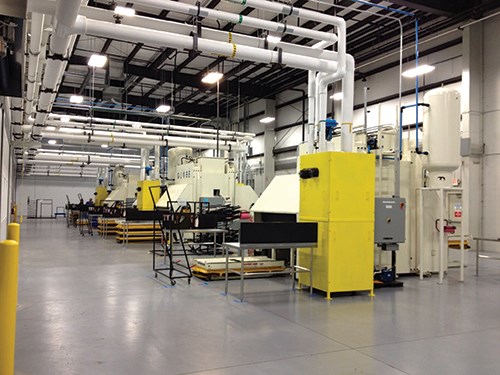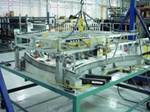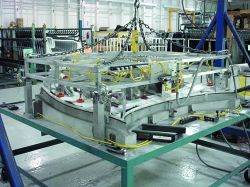Faster cycle, better surface: Out of the autoclave
GM is first automaker to use Class A CFRP parts from new pressure-press technology.
On Jan. 14, General Motors Co. (GM, Detroit, Mich.) introduced its 2014 Chevrolet Corvette Stingray reboot at the North American International Auto Show (NAIAS, Detroit, Mich.). Returning to the iconic Stingray name badge for the first time since it was retired in 1976, the new baseline Corvette is also the first production car to feature structural, Class A carbon fiber-reinforced plastic (CFRP) body panels produced via a new out-of-autoclave "pressure-press" technology. Invented by Plasan Carbon Composites (Bennington, Vt.), the process relies on equipment developed and built by Globe Machine Manufacturing Co. (Tacoma, Wash.).
The Stingray will be available for sale in the third quarter of this year. Its removable CFRP roof is available painted or in an exposed-weave/clear-coated version (a clear polycarbonate version is being produced by another supplier). The hood is painted to match the rest of the body. Each is formed and cured by Plasan’s process 75 percent faster than previous autoclaved parts, and they require 80 percent less postmold finishing.
Mass-producing mass reduction
The commercial debut of the hood and roof is a significant milestone for automotive composites. Pound for pound, carbon composites are the lightest, strongest construction materials available to industry. Automakers today readily acknowledge that they offer an ideal means to reduce vehicle mass without sacrificing occupant safety or driving performance as OEMs seek to meet more stringent U.S. fuel economy standards and significantly more difficult European tailpipe emission limits. But the high cost of carbon fiber, the time and expense of autoclave processing and a lack of predictive-engineering tools have kept away all but a handful of supercar and high-end sports car builders.
At such low volumes, autoclave cure is fast enough to supply parts. And since these tend to be premium or super-premium brands, the manufacturer's suggested retail price (MSRP) is high enough to recoup the expense of super-premium materials. However, when you move from a few thousand to tens of thousands of cars annually, autoclave cure becomes too slow and expensive — hence the scramble to find faster-curing resins and to develop new out-of-autoclave process derivatives.
“Corvette has pioneered the use of innovative, lightweight materials since its introduction in 1953 as the industry’s first production car with a fiberglass body,” notes Corvette chief engineer Tadge Juechter. “With the introduction of the new Stingray, the Corvette will continue that tradition by becoming the industry leader in high-volume use of carbon fiber. For the standard Stingray coupé, we'll use 18 lb [8.2 kg] of carbon fiber just on the roof and hood. Based on last year's sales of 14,132 units, Corvette will account for at least 238,000 lb [107,955 kg] of carbon fiber annually — and we expect to sell significantly more Corvette Stingrays than that."
Notably, the reborn Stingray was designed and engineered, and the pressure-press technology for its roof and hood were developed, during the darkest days of the post-2008 global economic collapse. GM was in bankruptcy, and although Plasan had supplied autoclave-cured CFRP body panels for Corvettes since 2006 — including the hood and fenders on the Z06; and the hood, roof, roof bow, splitter, rocker panels and fenders on the ZR1 — Plasan's new owners, who had purchased the automotive side of Vermont Composites Inc. only a few years earlier, were wondering why on earth they'd decided to diversify from their core defense business into the capricious world of cars. But GM persevered, even renovating the Corvette Bowling Green, Ohio, assembly plant. Likewise, Plasan's owners invested "tens of millions of dollars" to develop the new molding process, build a new technical center in Wixom, Mich., and then build a new production facility in Walker, Mich.
Plasan’s president, James Staargaard, says the Walker plant was built specifically to produce parts for the Corvette program. The facility houses five new Globe pressure presses, and hood and roof production will occupy half of the facility's available 170,000 ft2/15,794m2 manufacturing space (another 30,000 ft2/2,787m2 serves administrative purposes).
Gary Lownsdale, Plasan’s chief technology officer and coinventor of the process, sees the Walker facility’s mission as nothing less than an opportunity "to bring CFRP into mass production for cars." He adds that Plasan is the only TS-9000 certified CFRP part manufacturer in the world and says, about the Walker site, "You won't find another CFRP facility with the quality [capabilities] of this one." Further, there's room to expand, and he predicts the plant will be full within a few years.
Minimizing the makeover variables
Although the new Stingray panels are similar in size to those used on the ZR1, they have different contours. Staargaard says Plasan simplified approvals and minimized the number of variables during the changeover process by using the same resin, structural adhesive, clearcoat chemistry and laminate technology. Plasan did, however, make one significant change: the company is now hot bonding the hood’s inner and outer panels. The adhesive is heated while it is robotically applied, and parts are fixtured for cure at ambient temperature. This is 72 percent faster than the oven-cure method used on the ZR1.
The roof and hood are molded on Globe pressure presses fitted with 6-ft by 6-ft (1.8m by 1.8m) platens. Lownsdale says the large hood inner and outer panels and smaller roof can be molded on the same size press. "There's no economic advantage,” he notes, “to making a smaller machine owing to the low-energy consumption [vs. autoclave systems]." Plasan uses single-sided, thin-shell nickel vapor deposition (NVD) tools from Weber Manufacturing Technologies Inc. (Midland, Ontario, Canada). A reusable bladder/canopy is used to close off the B-side of the part during molding. Plasan produces the bladder in-house using silicone heat-cured rubber (HCR) from an undisclosed source. The bladder’s smooth surface eliminates wrinkles, read through and other blemishes typical of vacuum bags, providing a blemish-free B-side surface.
Each tool features built-in oil-type heating/cooling elements and, according to Plasan, provides precise thermodynamic control without inductive mold heating. Roof and hood tools can run in any Globe pressure press at the Walker site, as long as the platen is sufficiently large, since molding pressures are low (<150 psi/10.3 bar). Lownsdale explains that the outer footprint of the tool remains the same, regardless of part size, so they don't need to change any equipment inside the press when they change tools.
Most notably, Plasan developed a technology it calls Coupling Recognition System (CRS). As soon as a particular part’s tool is plugged into the press, the CRS not only automatically identifies what part the tool is designed to mold, but it also queues up the "cure recipe" (process settings) for optimum production, effectively providing plug-and-play functionality. The company is currently working on patent applications to protect the CRS invention.
Maximizing the molding process
Each part is hand layed in its NVD tool on an indexing table outside the press, using prepreg from a robotically cut kit produced in another part of the facility. "Unfortunately, the technology doesn't exist yet to do automated layup of very complex geometric parts with the compound sweeps that you find in automotive," says Lownsdale. "We've successfully automated layup of simple parts, and the ability to translate that to more complex designs is one of the goals we're chasing to continually decrease total cycle time."
When layup is complete, the canopy is pulled down over the part and smoothed into place. Then the table indexes into the press chamber, and the front and rear doors close. A pressure box (slightly larger than the tool) descends from above, completely sealing off the top and sides of the tool and bladder. A vacuum is drawn, and what is described as a "very small column of air" completely surrounds the tool and bladder inside the box. Pressure is applied to the top of the box (and, therefore, the column of air) by a hydraulic ram. In this sealed environment (which doesn't require nitrogen because the process tightly controls exotherm) the tool surface rapidly heats, enabling resin to flow quickly before crosslinking begins. The accelerated flow reportedly accounts for the much-improved surface finish, with far fewer voids, dry lines or pits.
Using conventional resin and laminate technology, Plasan can achieve a 10-minute cycle time with a six-minute cure, says Staargaard. But in practice the press maintains a "balanced" 17-minute cycle to avoid overproducing parts and getting ahead of the bonding, trimming and finishing stations. The process eliminates the expense of vacuum bagging materials and uses a small fraction of the energy consumed in an autoclave cycle. Moreover, the part’s excellent as-molded surface has accelerated downstream operations by requiring less of the Walker plant's new automated finishing process that features interchangeable routing and sanding equipment developed by KMT Robotic Solutions Inc. (Auburn Hills, Mich.)
Although he is pleased, Lownsdale says the benchmark is injection-molded surface quality and speed. To that end, Plasan is collaborating closely with all major resin and prepreg producers. Previously, he says, molding equipment would have been unable to keep pace with fast-cure resin systems, “but now, equipment is pushing the chemistry, and people are responding really quickly to catch back up."
Moving into the mainstream
With better economics and quality, which translates to less secondary finishing, labor, material waste and capital investment, "it's absolutely possible to make CFRP components mass producible in the auto industry," Lownsdale says, noting that "the supply base is quite energized." He says Plasan and CFRP have come a long way in the past few years with automakers, too. "Now, when we sit down and talk seriously about a CFRP component, our customer no longer says, Prove it to me and I'll consider it, but rather says, How can we work together to make this happen?"
Staargaard adds, "Historically, we've had to take a design originally produced for aluminum or SMC and make it carbon. But now people are coming to us to make it carbon from the start to get the highest cost/performance efficiency. That's a big change and that's very recent."
Juechter concludes, "We focused on carbon fiber for the program because it is exceptionally strong and lightweight, and perfectly suited for a sports car where performance and power-to-weight are paramount. It also contributed to our goal of improving the fuel economy of the Corvette. We believe the result defines the future of modern performance cars, as the new Stingray delivers the fastest acceleration, the most cornering grip, the most track capability, the best braking performance and what we expect to be the best fuel economy ever for a standard Corvette.”
Related Content
Composites end markets: Automotive (2024)
Recent trends in automotive composites include new materials and developments for battery electric vehicles, hydrogen fuel cell technologies, and recycled and bio-based materials.
Read MoreThermoplastic composites: Cracking the horizontal body panel nut
Versatile sandwich panel technology solves decades-long exterior automotive challenge.
Read MoreCo-molding SMC with braided glass fiber demonstrates truck bed potential
Prepreg co-molding compound by IDI Composites International and A&P Technology enables new geometries and levels of strength and resiliency for automotive, mobility.
Read MoreASCEND program update: Designing next-gen, high-rate auto and aerospace composites
GKN Aerospace, McLaren Automotive and U.K.-based partners share goals and progress aiming at high-rate, Industry 4.0-enabled, sustainable materials and processes.
Read MoreRead Next
Corvette gets leaner with carbon fiber hood
Advances in materials and processing yield high-volume, low-mass hood for GM flagship.
Read MoreDeveloping bonded composite repair for ships, offshore units
Bureau Veritas and industry partners issue guidelines and pave the way for certification via StrengthBond Offshore project.
Read More“Structured air” TPS safeguards composite structures
Powered by an 85% air/15% pure polyimide aerogel, Blueshift’s novel material system protects structures during transient thermal events from -200°C to beyond 2400°C for rockets, battery boxes and more.
Read More
.jpg;width=70;height=70;mode=crop)























